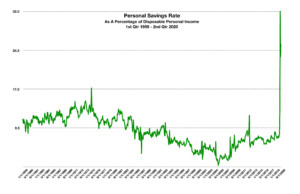Stock Indices:
| Dow Jones | 39,807 |
| S&P 500 | 5,254 |
| Nasdaq | 16,379 |
Bond Sector Yields:
| 2 Yr Treasury | 4.59% |
| 10 Yr Treasury | 4.20% |
| 10 Yr Municipal | 2.52% |
| High Yield | 7.44% |
Commodity Prices:
| Gold | 2,254 |
| Silver | 25.10 |
| Oil (WTI) | 83.12 |
Currencies:
| Dollar / Euro | 1.08 |
| Dollar / Pound | 1.26 |
| Yen / Dollar | 151.35 |
| Canadian /Dollar | 0.73 |
Equities Taper Off In September – Domestic Equity Overview
Despite a pullback in September, equities managed to end the third quarter with gains. The technology sector was the primary contributor to the S&P 500 Index, which was up 8.93% for the third quarter. Consumer discretionary and industrial stocks also performed well during the quarter, exemplifying some economic recovery characteristics.
Following an upward surge during this summer, September witnessed a tapering of equity momentum, leading to lower valuations. The three major equity indices, Dow Jones Industrial, S&P 500 Index, and the Nasdaq were off in September, but positive for the third quarter ending September 30th.
Sources: S&P, Bloomberg, Dow Jones, Nasdaq 
Every five years the U.S. government revises the Dietary Guidelines for Americans, which govern school lunch programs, shape health promotion efforts, influence what food manufacturers produce, and give Americans an idea of how to make healthy food choices for themselves and their families. As obesity rates continue to rise, the Federal committee has concluded that the new limit for added sugar consumption will be 6% of daily caloric intake, down from 10%, in an attempt to curb consumption of processed foods and reduce incidence of obesity in America.
In 2017-2018, over 42% of U.S. adults and 18% of children aged 12-19 were obese. Obesity is linked to not only the risk of developing cardiovascular disease, certain types of cancer, and Type 2 Diabetes, but also increased risk for severe symptoms with COVID-19. Most Americans are unable or ill-equipped to limit their sugar consumption to the previous recommended limit of 10% or less of daily caloric intake, and many food industry lobbying groups claim that a sugar intake limit of 10% is “ambitious enough” already.
The committee of 20 doctors, elected and screened by the United States Department of Agriculture (USDA) and U.S. Department of Health and Human Services (HHS) officials, decided on the new 6% limit by analyzing the need for essential nutrients in the average American’s diet, then taking the leftover “discretionary” calories and allowing for some consumption of solid fats and added sugars.
The added sugar guideline is to be applied to processed and sweetened foods, but not to foods that naturally contain sugar, like fruit and milk. These whole foods provide nutritional benefits which most Americans do not eat enough of.
The main offenders when it comes to added sugars are sweetened beverages and processed foods. Coffee, tea, and juice can hide a lot of added sweetener, as well as flavored yogurts and other snack foods. Public health officials suggest that Americans avoid “drinking their calories”, choose unprocessed foods, and opt for unsweetened versions of their favorite snacks.
Sources: United States Department of Agriculture, CDC, U.S. Department of Health and Human Services Rates Vacillate As Stimulus Efforts Unresolved – Fixed Income Overview
The Federal Reserve continues to purchase $120 billion of Treasury and mortgage agency bonds each month, expanding its balance sheet to over $7 trillion as of the end of September. The monumental buying is meant to facilitate bond market activity while maintaining a relatively low-rate environment.
Yields on government and corporate bonds vacillated in September as uncertainty surrounding additional stimulus efforts influenced rates. Analysts and economists expect higher long-term rates to result from the incremental debt issuance to pay for the next stimulus package.
Sources: U.S. Treasury, Federal Reserve, Bloomberg